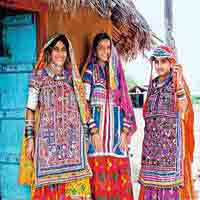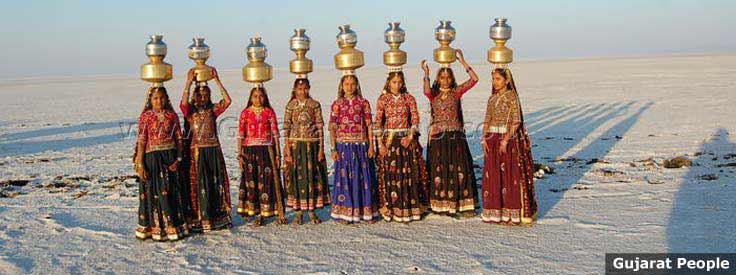Home
Gujarat People
Gujarat People
The majority of the populace dwelling in Gujarat is of Indo-Aryan genesis. Roughly 20% of the People in Gujarat are tribal and the Dhubla, Bhils, Naikda, Kolis are some of the tribes which can be still seen in Gujarat. The Aryans are said to be the conventional rulers of Gujarat and the first people to migrate from the north that conquered the Bhils. The Kolis tribe is also important and has an intermediate social position between the Aryans and the Bhils. Aryans are now commonly identified as Hindus. In the medieval period the Zoroastrianism and Islam came to Gujarat and begin the progress of a multi-religious society. The peninsula of Kathiawar is known after the Kathis who has migrated to Saurashtra at the time of the fourteenth century. Their origin is not exactly known but it is viable that they were pushed southwards by means of the Muslim invaders. The Chotila and Khachar were the principal seats of the Kathis. They were worshippers of the sun and were nomadic and also had developed horse-breeding in Gujarat. The immigrants from different parts of India have led to formation of various cultures and communities in Kathiawar. The robust royal families which defeated Saurashtra later headquartered their rule in Saurashtra. The Gujarat People, Rabaris are the neighborhood of cattle-breeders who came from Marwar and Sindh and and declare a Rajput ancestry. The Gujarat People, Rabaris are interesting because of their costumes and features and live nomadic lifestyles. The tribal populaces in the hilly regions have maintained farming. Some of the vegetation grown by tribals is Rice, groundnut, bajra and jowar. You can also check out various Gujarat Tours package that offer tribal tour of Gujarat.
People of Gujarat
 The tribal people in Gujarat have engaged themselves in artwork like wood-cutting which they sell in small cities to buy their day-to-day life basic needs. Many of the tribal Gujarat people are busy in forest industry. The Gujarati People, the populace of Gujarat, can be found in all parts of the state. The Gujarat people find their ancestry from the Gurjars. They are said to be have migrated to India with Huns while travelling through Punjab and finally settled in Gujarat. The Gujarati people had been highly impacted by the cultural of mainland and welcomed the monarchies that controlled them. Some Hindu traditions like Vaishnavism and Shavism had been adopted by Gujarat. Nowadays, the word Gujarati does not associate with a specific tribe of immigrants or a specific populace. The natives of the peninsula of Kutch, Kutchi Gujarat people, have their own language. The Kutchi Gujarat people are both Hindus and Muslims and a significant number of them have come from Sindh. Gujarati people, adult males normally wear long or short coat, turban cap and dhoti. Nowadays Gujarati people are wearing pants. The womens in Gujarat normally wear blouse and saree. Parsi mens normally wear headgear, long coat and pants. The Parsi womens also normally wear blouse and saree and their blouse have long sleeves and take shawl on the saree. The ornaments of the ladies are also changing according to time. They are more and more attractive. The womens in Gujarat usually wear bangles, rings, slender chains and ear-rings.
The tribal people in Gujarat have engaged themselves in artwork like wood-cutting which they sell in small cities to buy their day-to-day life basic needs. Many of the tribal Gujarat people are busy in forest industry. The Gujarati People, the populace of Gujarat, can be found in all parts of the state. The Gujarat people find their ancestry from the Gurjars. They are said to be have migrated to India with Huns while travelling through Punjab and finally settled in Gujarat. The Gujarati people had been highly impacted by the cultural of mainland and welcomed the monarchies that controlled them. Some Hindu traditions like Vaishnavism and Shavism had been adopted by Gujarat. Nowadays, the word Gujarati does not associate with a specific tribe of immigrants or a specific populace. The natives of the peninsula of Kutch, Kutchi Gujarat people, have their own language. The Kutchi Gujarat people are both Hindus and Muslims and a significant number of them have come from Sindh. Gujarati people, adult males normally wear long or short coat, turban cap and dhoti. Nowadays Gujarati people are wearing pants. The womens in Gujarat normally wear blouse and saree. Parsi mens normally wear headgear, long coat and pants. The Parsi womens also normally wear blouse and saree and their blouse have long sleeves and take shawl on the saree. The ornaments of the ladies are also changing according to time. They are more and more attractive. The womens in Gujarat usually wear bangles, rings, slender chains and ear-rings.
People in Gujarat
The whole populace of the Gujarat state consists of Hindus, Jains and Muslims. Parsi people can also be seen in Gujarat. The Hindu people in Gujarat compulsorily follow caste system. The Brahmins and Banias occupations are well decided. The Patidars who owns properties and land are considered as the best agriculturists and also play an important role in political and economic life of the Gujarat People. They are divided into four classes Levas, Kadawas, Anjana and Uda.
Tribal People of Gujarat
There are many tribal communities in Gujarat. Check out the list of tribal People of Gujarat.
Ahir
The least nomadic of the rural communities, many Ahirs started businesses in salt production, carpentry and transport among other areas to maintain their income. Although found all over India, a large number of Ahirs have settled in Gujarat. The Ahirs have a rich tradition of folk dance like Raas and folk songs. The Ahir women from each sub-community wear outfits like lovely bright tops and black gaghra. The Ahirs are popular for their torans and wall hangings and womens are expert in embroidery.
Bharvad
The Bharvads believe that their forefather migrated with Krishna and the Yadav gens from Mathura to Gujarat. The Bharvads can be found in all parts of the state. This community of cattle breeders gathers at the Tarnetar Far in Surendranagar every year. The men are popular for their lovely outfits, which includes colorful dhoti with handwork and fully embroidered bright vests and vivid turbans. They acknowledge each other with a hearty "Ram, Ram". The men women both give importance to ornamentation. They also draw tattoos. The Bharvads believe that a person who dies takes next birth.as a camel.
Bhil
It is said that the Bhils were the ancient traditional rulers of Gujarat. The Bhil community, can be found in the eastern border of Gujarat, includes of several smaller gens, including Tadvi, Valvi, Vasava Bhil-Garsias and Bhilalas. They all live away from the forest and are dependent on bamboos, for building their houses, for make farming tools and for prepare food items such as pickled bamboo shoots. The Bhils are mostly agriculturalists, they sell their produce at weekly bazaars. They have a powerful relationship with nature, which can be seen in their art forms such as terracotta figures, totems and masks, which are mostly related to rituals. The Bhils also have a rich tradition of folk music and folk dancing.
Dangis
The Dangis community is a mixed population including Bhils, Naikas, Kunbis, Gamits and Warlis all of them share the forests of the Dangs, while sustaining their own cultural identity. The Kunbis, Bhils and Gamits are indigenous and the Naikas and Warlis migrated to the area. All Dangi women wear a golden nose ring and a necklace made of one rupee coins. The Dangis also enjoy social and economic justice from childhood.
Jath
The Jath community is said to be originated from Aleppo in Turkey, this semi-nomadic community can be found along both sides of the once perpetual Indus River. The Jath community is subdivided into three main groups, the Garasias (farmers), Dhanetas (cattleman) and Fakiranis (landowners). The women outfit includes long gowns decorated with a beautiful embroidered yoke. The Jath embroidery is one of the finest embroidery works in India. A unique feature of the Dhaneta women is that they wear large gold nose ring. This large gold nose ring is held up by a bundle of black threads attached to their hair.
Meghwal
The Meghwal community is originally from Marwar, Rajasthan. The Meghwals live in Kachchh and can be seen in the border of villages settled by Muslim animal herders. The Meghwals are expert tanners and wool weavers. Many of the men have started doing wood carving, which they use to decorate furniture and other woodwork. The women are expert in embroidery, clay work decorated around small pieces of mirror. The married women wear blouses called kanjaris, whose front side is fully decorated with bold embroidery designs. On festivals and fairs, the women wear an intricately designed gold nose ring called velado that hangs over the mouth.
Mutwa
It is said that a hijra led the Mutwas from Arabia to Kachchh via Sindh about 500 years ago. The Mutwa still follow the Bedouin culture and practice Islam. The Mutwas are mostly cattle breeders. The Mutwas are also experts in artwork such as eye-catching mud work with lipan and mirrors. The wedding clothes and other materials among the Mutwas include silver and gold jewelry, embroidered clothing, handmade quilts and big metal vessels.
Rabari
The Rabari community is a pastoral community, the Rabaris came from Marwar, Rajasthan. According to traditional beliefs, a group of Rajput men decided to marry heavenly woman, and the offspring of this union came to be known as Rabari. The Rabari community can be seen in all parts of Gujarat. The Rabaris performs all marriage ceremonies on a single day of the year. Many Rabaris are semi-nomadic. The married Rabari women wear black woolen dupattas with red dots, black enormously pleated skirts called gaghra and a bare back blouse embellished with handiwork. The Rabari women wear heavy coiled earrings known as nagla. The Rabari women also have tattoos on their hands and neck. The Rabari men outfit includes all white, from their turbans and kediyun to a dhoti-like bottom. The Rabari men sometimes take an embroidered wool shawl on the shoulder. The Rabari men also wear earrings called as toliya.
Rathwa
The Rathwa are an agriculture community. Many of the Rathwa get their income through wage labor and animal husbandry. The Rathwas are dependent on the forest aress for agricultural land, wild animals for food and wooden for fuel. The Rathwa community celebrates a number of festivals related to the harvest cycle such as vibrant Kawant Mela, which marks the start of spring.
